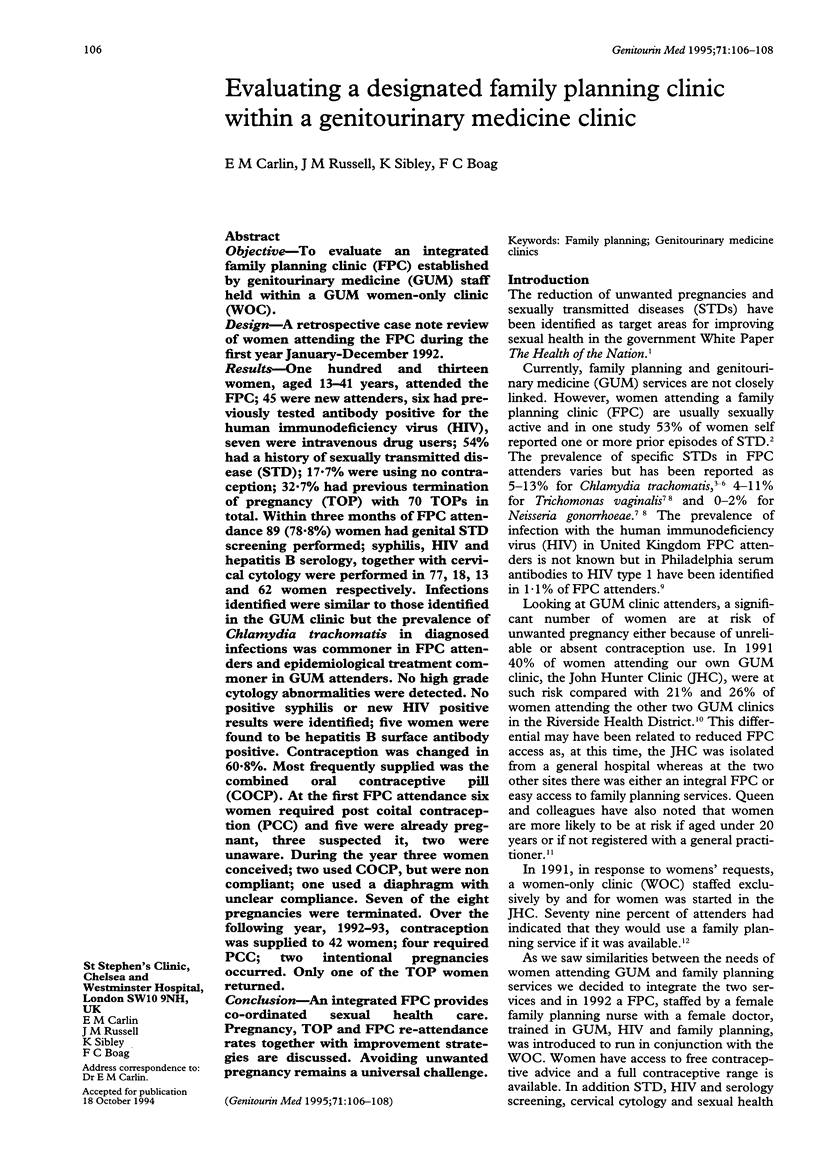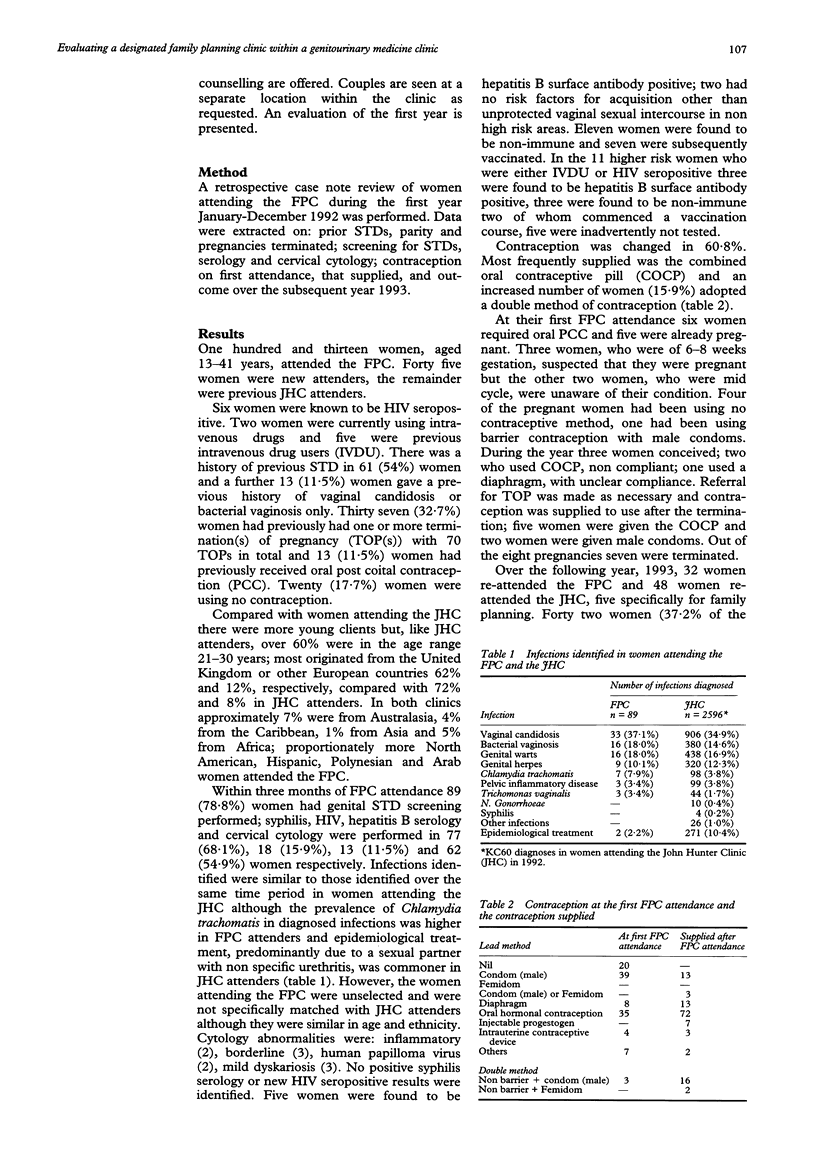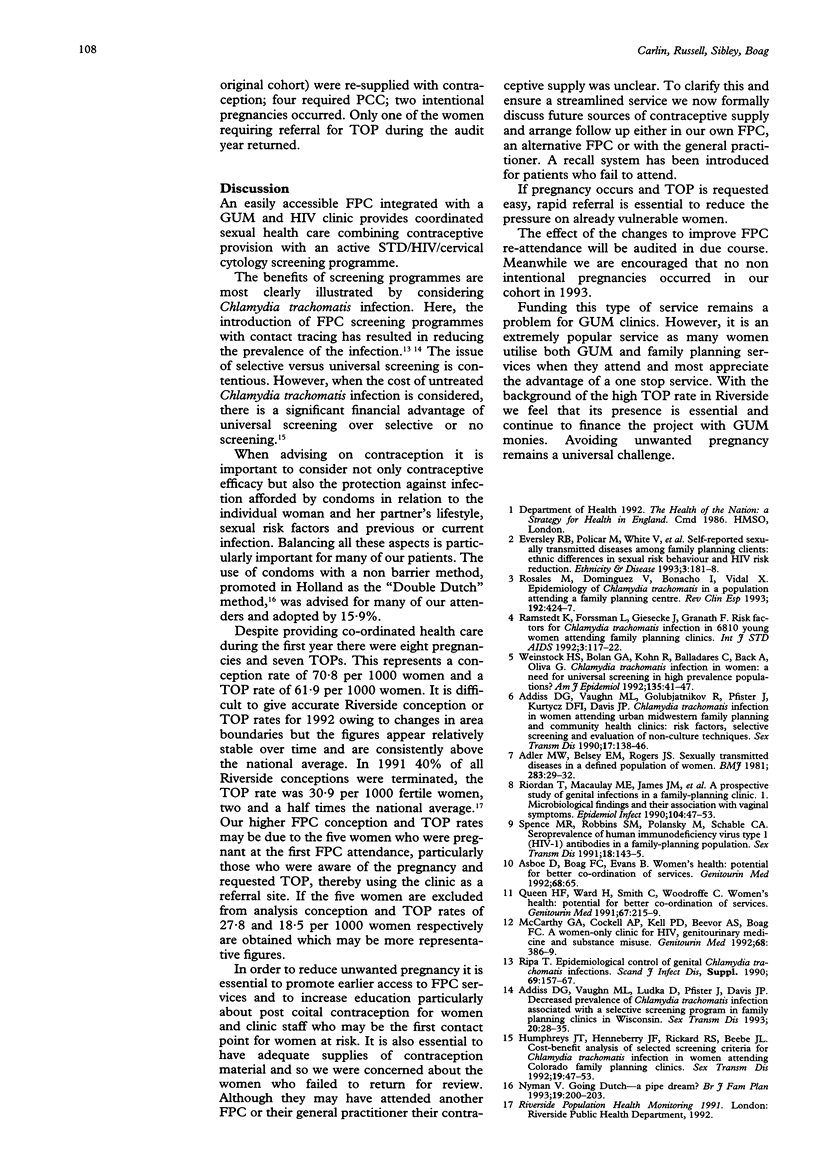Abstract
OBJECTIVE--To evaluate an integrated family planning clinic (FPC) established by genitourinary medicine (GUM) staff held within a GUM women-only clinic (WOC). DESIGN--A retrospective case note review of women attending the FPC during the first year January-December 1992. RESULTS--One hundred and thirteen women, aged 13-41 years, attended the FPC; 45 were new attenders, six had previously tested antibody positive for the human immunodeficiency virus (HIV), seven were intravenous drug users; 54% had a history of sexually transmitted disease (STD); 17.7% were using no contraception; 32.7% had previous termination of pregnancy (TOP) with 70 TOPs in total. Within three months of FPC attendance 89 (78.8%) women had genital STD screening performed; syphilis, HIV and hepatitis B serology, together with cervical cytology were performed in 77, 18, 13 and 62 women respectively. Infections identified were similar to those identified in the GUM clinic but the prevalence of Chlamydia trachomatis in diagnosed infections was commoner in FPC attenders and epidemiological treatment commoner in GUM attenders. No high grade cytology abnormalities were detected. No positive syphilis or new HIV positive results were identified; five women were found to be hepatitis B surface antibody positive. Contraception was changed in 60.8%. Most frequently supplied was the combined oral contraceptive pill (COCP). At the first FPC attendance six women required post coital contraception (PCC) and five were already pregnant, three suspected it, two were unaware. During the year three women conceived; two used COCP, but were non compliant; one used a diaphragm with unclear compliance. Seven of the eight pregnancies were terminated. Over the following year, 1992-93, contraception was supplied to 42 women; four required PCC; two intentional pregnancies occurred. Only one of the TOP women returned. CONCLUSION--An integrated FPC provides co-ordinated sexual health care. Pregnancy, TOP and FPC re-attendance rates together with improvement strategies are discussed. Avoiding unwanted pregnancy remains a universal challenge.
Full text
PDF


Selected References
These references are in PubMed. This may not be the complete list of references from this article.
- Addiss D. G., Vaughn M. L., Golubjatnikov R., Pfister J., Kurtycz D. F., Davis J. P. Chlamydia trachomatis infection in women attending urban midwestern family planning and community health clinics: risk factors, selective screening, and evaluation of non-culture techniques. Sex Transm Dis. 1990 Jul-Sep;17(3):138–146. doi: 10.1097/00007435-199007000-00006. [DOI] [PubMed] [Google Scholar]
- Addiss D. G., Vaughn M. L., Ludka D., Pfister J., Davis J. P. Decreased prevalence of Chlamydia trachomatis infection associated with a selective screening program in family planning clinics in Wisconsin. Sex Transm Dis. 1993 Jan-Feb;20(1):28–35. doi: 10.1097/00007435-199301000-00006. [DOI] [PubMed] [Google Scholar]
- Adler M. W., Belsey E. M., Rogers J. S. Sexually transmitted diseases in a defined population of women. Br Med J (Clin Res Ed) 1981 Jul 4;283(6283):29–32. doi: 10.1136/bmj.283.6283.29. [DOI] [PMC free article] [PubMed] [Google Scholar]
- Asboe D., Boag F., Evans B. Women's health: potential for better co-ordination of services. Genitourin Med. 1992 Feb;68(1):65–65. doi: 10.1136/sti.68.1.65. [DOI] [PMC free article] [PubMed] [Google Scholar]
- Eversley R. B., Policar M., White V., Grinstead O., Newstetter A., Avins A., Hearst N. Self-reported sexually transmitted diseases among family planning clients: ethnic differences in sexual risk behavior and HIV risk reduction. Ethn Dis. 1993 Spring;3(2):181–188. [PubMed] [Google Scholar]
- Humphreys J. T., Henneberry J. F., Rickard R. S., Beebe J. L. Cost-benefit analysis of selective screening criteria for Chlamydia trachomatis infection in women attending Colorado family planning clinics. Sex Transm Dis. 1992 Jan-Feb;19(1):47–53. doi: 10.1097/00007435-199201000-00010. [DOI] [PubMed] [Google Scholar]
- McCarthy G. A., Cockell A. P., Kell P. D., Beevor A. S., Boag F. C. A women-only clinic for HIV, genitourinary medicine and substance misuse. Genitourin Med. 1992 Dec;68(6):386–389. doi: 10.1136/sti.68.6.386. [DOI] [PMC free article] [PubMed] [Google Scholar]
- Queen H. F., Ward H., Smith C., Woodroffe C. Women's health: potential for better coordination of services. Genitourin Med. 1991 Jun;67(3):215–219. doi: 10.1136/sti.67.3.215. [DOI] [PMC free article] [PubMed] [Google Scholar]
- Ramstedt K., Forssman L., Giesecke J., Granath F. Risk factors for Chlamydia trachomatis infection in 6810 young women attending family planning clinics. Int J STD AIDS. 1992 Mar-Apr;3(2):117–122. doi: 10.1177/095646249200300208. [DOI] [PubMed] [Google Scholar]
- Riordan T., Macaulay M. E., James J. M., Leventhall P. A., Morris E. M., Neal B. R., Rowland J., Evans B. M. A prospective study of genital infections in a family-planning clinic. 1. Microbiological findings and their association with vaginal symptoms. Epidemiol Infect. 1990 Feb;104(1):47–53. doi: 10.1017/s0950268800054510. [DOI] [PMC free article] [PubMed] [Google Scholar]
- Ripa T. Epidemiologic control of genital Chlamydia trachomatis infections. Scand J Infect Dis Suppl. 1990;69:157–167. [PubMed] [Google Scholar]
- Rosales M., Domínguez V., Bonacho I., Vidal X. Epidemiología de Chlamydia trachomatis en una población que acude a un Centro de Planificación Familiar. Rev Clin Esp. 1993 May;192(9):424–427. [PubMed] [Google Scholar]
- Spence M. R., Robbins S. M., Polansky M., Schable C. A. Seroprevalence of human immunodeficiency virus type I (HIV-1) antibodies in a family-planning population. Sex Transm Dis. 1991 Jul-Sep;18(3):143–145. doi: 10.1097/00007435-199107000-00003. [DOI] [PubMed] [Google Scholar]
- Weinstock H. S., Bolan G. A., Kohn R., Balladares C., Back A., Oliva G. Chlamydia trachomatis infection in women: a need for universal screening in high prevalence populations? Am J Epidemiol. 1992 Jan 1;135(1):41–47. doi: 10.1093/oxfordjournals.aje.a116200. [DOI] [PubMed] [Google Scholar]


